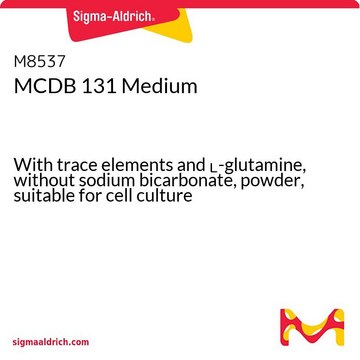M7403
MCDB 153 Medium
With trace elements, L-glutamine and 28mM HEPES, without sodium bicarbonate, powder, suitable for cell culture
Sinonimo/i:
Molecular, Cellular, and Development Biology 153 medium
About This Item
Prodotti consigliati
Livello qualitativo
Forma fisica
powder
tecniche
cell culture | mammalian: suitable
Componenti
NaHCO3: no
L-glutamine: 0.8772 g/L
glucose: 1.081 g/L (Dextro)
sodium pyruvate: 0.055 g/L
phenol red: 0.001242 g/L
HEPES: 6.6 g/L (25mM)
Condizioni di spedizione
ambient
Temperatura di conservazione
2-8°C
Descrizione generale
Applicazioni
Quantità
Ricostituzione
Comunemente ordinati con questo prodotto
Codice della classe di stoccaggio
11 - Combustible Solids
Classe di pericolosità dell'acqua (WGK)
WGK 1
Punto d’infiammabilità (°F)
Not applicable
Punto d’infiammabilità (°C)
Not applicable
Certificati d'analisi (COA)
Cerca il Certificati d'analisi (COA) digitando il numero di lotto/batch corrispondente. I numeri di lotto o di batch sono stampati sull'etichetta dei prodotti dopo la parola ‘Lotto’ o ‘Batch’.
Possiedi già questo prodotto?
I documenti relativi ai prodotti acquistati recentemente sono disponibili nell’Archivio dei documenti.
I clienti hanno visto anche
Il team dei nostri ricercatori vanta grande esperienza in tutte le aree della ricerca quali Life Science, scienza dei materiali, sintesi chimica, cromatografia, discipline analitiche, ecc..
Contatta l'Assistenza Tecnica.





